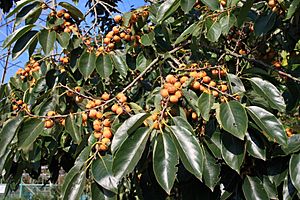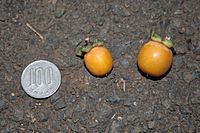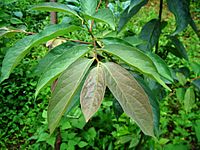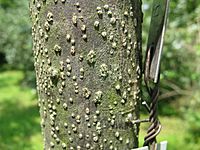Date-plum facts for kids
Quick facts for kids Date-plum |
|
|---|---|
 |
|
| Branches with fruit | |
| Scientific classification | |
| Genus: |
Diospyros
|
| Species: |
lotus
|
| Synonyms | |
|
|
The Date-plum (scientific name: Diospyros lotus) is a special type of tree. People also call it the Caucasian persimmon or lilac persimmon. It grows naturally in warm parts of Asia and Europe. The tree gets its English name from its small fruits. These fruits taste a bit like plums and also like dates. The Date-plum is one of the oldest plants that humans have grown!
Contents
Where Does the Date-Plum Grow?
The Date-plum tree grows from East Asia all the way to the western Mediterranean, including Spain. It is originally from southwest Asia and southeast Europe.
Ancient Greeks knew this fruit as "God's fruit." This is why the scientific name for its group of plants, Diospyros, means "God's fruit" in Greek. The English name "date-plum" likely comes from the Persian word Khormaloo. This word literally means "date-plum" and describes the fruit's taste. In Pakistan, the fruit is called Amlok and is often eaten dried.
Some people think this tree might be the famous "lotus tree" from The Odyssey. In that ancient story, anyone who ate the lotus fruit forgot about going home. They just wanted to stay and eat more with the lotus-eaters!
Growing Conditions
This tree grows well in lower and middle mountain areas in the Caucasus region. It usually grows up to 600 meters (about 2,000 feet) above sea level. In Central Asia, it can grow even higher, up to 2,000 meters (about 6,500 feet).
Date-plum trees do not often grow in large groups by themselves. Instead, they usually grow alongside other trees like hackberry, ash, and maple. They are not picky about the soil and can even grow on rocky slopes. However, they need a lot of sunlight to grow well. People also grow these trees in places like the U.S. and North Africa.
What Does the Date-Plum Look Like?
The Date-plum is a tall tree, reaching heights of 15 to 30 meters (about 50 to 100 feet). Its old bark peels off as the tree gets older.
Leaves and Flowers
The leaves are shiny and feel a bit leathery. They are oval-shaped with pointed ends. Each leaf is usually 5 to 15 centimeters (2 to 6 inches) long and 3 to 6 centimeters (1 to 2 inches) wide.
The flowers are small and greenish. They usually appear on the tree in June or July.
Fruit and Seeds
The fruits are like small berries with juicy insides. When they are ripe, they turn yellow. Each fruit is about 1 to 2 centimeters (less than an inch) across. Inside the fruit are seeds with a thin outer skin and a very hard inner part.
How Do People Use Date-Plums?
The fruits of the Caucasian persimmon are good to eat! They contain a lot of natural sugar, malic acid (which gives them a tart taste), and vitamins. People eat them fresh, or they wait until after the first frost. They are also often dried. Both drying and frost help to remove the tart taste from the fruit, making them sweeter and more enjoyable.
See also
 In Spanish: Diospyros lotus para niños
In Spanish: Diospyros lotus para niños




